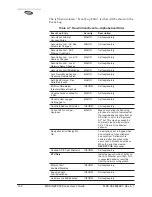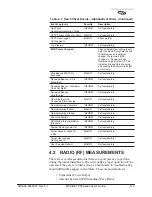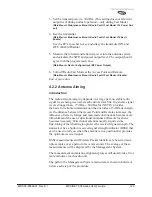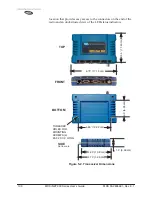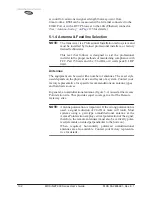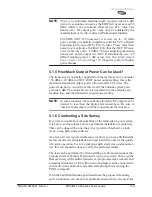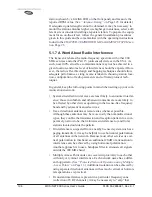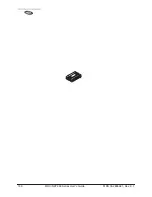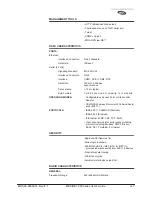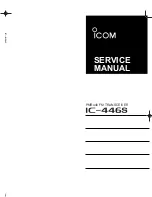
MDS 05-2806A01, Rev. E.1
MDS iNET 900 Series User’s Guide
135
NOTE:
There is no minimum feedline length required when a 6 dBi
gain or less antenna is used, as the EIRP will never exceed 36
dBm which is the maximum allowed, per FCC rules. The
transceiver’s RF output power may only be adjusted by the
manufacturer or its sub-contracted Professional Installer.
The MDS iNET II Transceiver is factory set to +29 dBm
power output to maintain compliance with the FCC’s Digital
Transmission System (DTS) Part 15 rules. These rules limit
power to a maximum of 8 dBm/3 kHz, thus the iNET II Trans-
ceiver is factory set to +29 dBm. When calculating maximum
transceiver power output for iNET II installations, use +29
dBm if antenna gain is 6 dBi or less. See
How Much Output
Power Can be Used? on Page 135
for power control of higher
gain antennas.
5.1.5 How Much Output Power Can be Used?
The transceiver is normally supplied from the factory set for a nominal
+30 dBm (+29 dBm for iNET II) RF power output setting; this is the
maximum transmitter output power allowed under FCC rules. The
power must be decreased from this level if the antenna system gain
exceeds 6 dBi. The allowable level is dependent on the antenna gain,
feedline loss, and the transmitter output power setting.
NOTE:
In some countries, the maximum allowable RF output may be
limited to less than the figures referenced here. Be sure to
check for and comply with the requirements for your area.
5.1.6 Conducting a Site Survey
If you are in doubt about the suitability of the radio sites in your system,
it is best to evaluate them before a permanent installation is underway.
This can be done with an on-the-air test (preferred method); or indi-
rectly, using path-study software.
An on-the-air test is preferred because it allows you to see firsthand the
factors involved at an installation site and to directly observe the quality
of system operation. Even if a computer path study was conducted ear-
lier, this test should be done to verify the predicted results.
The test can be performed by first installing a radio and antenna at the
proposed Access Point (AP) station site (one-per-system). Then visit the
Remote site(s) with another transceiver (programmed as a remote) and
a hand-held antenna. (A PC with a network adapter can be connected to
each radio in the network to simulate data during this test using the
PING command.)
With the hand-held antenna positioned near the proposed mounting
spot, a technician can check for synchronization with the Access Point
Summary of Contents for iNET 900 Series
Page 10: ...2 MDS iNET 900 Series User s Guide MDS 05 2806A01 Rev E 1 ...
Page 26: ...18 MDS iNET 900 Series User s Guide MDS 05 2806A01 Rev E 1 ...
Page 118: ...110 MDS iNET 900 Series User s Guide MDS 05 2806A01 Rev E 1 ...
Page 120: ...112 MDS iNET 900 Series User s Guide MDS 05 2806A01 Rev E 1 ...
Page 136: ...128 MDS iNET 900 Series User s Guide MDS 05 2806A01 Rev E 1 ...
Page 148: ...140 MDS iNET 900 Series User s Guide MDS 05 2806A01 Rev E 1 ...
Page 150: ...142 MDS iNET 900 Series User s Guide MDS 05 2806A01 Rev E 1 ...
Page 164: ...156 MDS iNET 900 Series User s Guide MDS 05 2806A01 Rev E 1 ...
Page 172: ...164 MDS iNET 900 Series User s Guide MDS 05 2806A01 Rev E 1 ...


